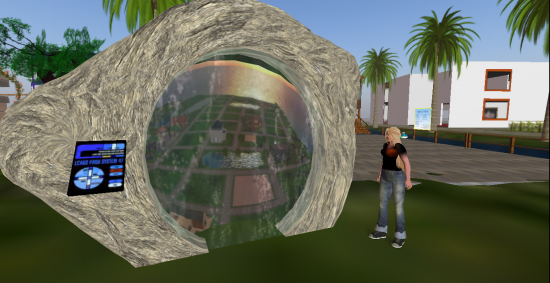Content creators may worry about preserving their content in an era of ubiquitous hypergrid connectivity, but most users have a different worry — preserving their stuff.
Hypergrid 1.5 rolled out security measures that protect rogue grid owners from dipping into the inventories of hypergrid visitors and causing trouble.
But there were still problems.
In particular, several hypergrid travelers have told me that they have sometimes lost attachments while traveling the hypergrid.

“That was a bug, but it has been fixed in the last release,” hypergrid inventor Crista Lopes told Hypergrid Business. Lopes is also a professor of informatics at the University of California, Irvine.
Scripted attachments are particularly problematic.
“In theory, hypergridding with scripted attachments should work,” said OpenSim core developer Melanie Thielker, who is also the founder and owner of the Avination grid. “However, in theory, theory and practice re the same, while they differ in practice.”
When a user teleports from one grid to another, it may seem that the entire avatar, and its whole inventory, travels along. The way it actually works, however, is that everything remains on the home grid and worn items are just fetched temporarily by the destination grid so that they can be displayed. But they’re not fetched all at once.
“The avatar’s current state and all the attachment objects are packed into what we term a ‘fatpack’,” Thielker explained. “This is a single message that defines the entire avatar. This is then sent to the destination. However, assets that comprise the contents of the objects are not sent in the fatpack. These must be loaded from the origin if the destination wants them.”
And that’s where problems can come up, she said. The destination grid might refused to accept outside scripts, for example, or demand scripts that are in compiled form instead of binary form — even though they’re only sent in binary form. Or the origin grid may refuse to provide script source code if it’s not full perm, or if it’s not in the hypergrid-friendly “suitcase” folder in the inventory — or just because the grid’s policy is not to allow scripts to travel out.

“Finally, the source may arrive to late and cause a compilation failure at the destination,” she said.  “IIn all the above cases, the scripts will not run, however, the object itself should still survive. I can not see how an object could be removed from the source grid’s main avatar inventory, if that happens it certainly bears investigating.”
Meanwhile, both Thielker and Canto are working on the next generation of hypergrid security — Hypergrid 2.0 — which will allow creators to set a new permission for their creations, allowing or disallowing hypergrid travel for that particular object.
With the new system, creators of high-end content on commercial grids can choose to have their objects restricted to their home grids — while other creators can choose to allow their creations to travel the hypergrid.
The reason this is needed is that some grids have very strict content protection standards. This typically means that the grid owners control all regions and don’t allow third-party to connect regions, that users aren’t allowed to have “God powers” that would enable them to change permissions on objects, and users can’t export entire, unfiltered region backups — OAR files — or inventory backups — IAR files. This ensures a similar level of content security as available in Second Life.
Other grids have different policies. For example, owners of small grids set their own policies. They can make backups of any region on their grid, give themselves “God powers,” or even access the asset database directly and make changes to content permissions. This can make a lot of sense — after all, a school district, say, should have the ability to manage its own grid and manage all its content.
Similarly, non-profit, open grids like OSGrid and Francogrid and ScienceSim allow anyone to connect their own regions. Users who run regions on their own computers can also, if they have the technical skills, to access the underlying database of region objects. They can also give themselves “God powers” and make backups of the entire region.

Many creators are concerned about the possibility of seeing their products travel to these grids, where there are fewer technical protections for their content.
Other creators don’t mind. They might be producing promotional content, for example, and want to see it spread as far as possible. Or they might focus on corporate and education buyers who need to take content to their private grids, but can usually be counted on to respect copyright. Or they might simply feel that there is really no good practical way to protect content against the most determined hackers, and that offering content with few restrictions at a reasonable price is the best way to fight piracy — together, of course, with promptly filing takedown notices against distributors of infringing content.
It’s a hot-topic issue in OpenSim, with many vocal supporters on both sides.
With Hypergrid 2.0, the decision can be left up to the people most concerned — the creators themselves.
Avination and Kitely are expected to open up to the hypergrid once the new standard is in place, increasing the hypergrid population from  a little over 7,000 active monthly users today on the 81 hypergrid-enabled grids that report these numbers, to around 10,000 active users.
The Hyperica hypergrid directory currently tracks 98 hypergrid-enabled grids, but not all report their user numbers. In addition, there are also non-public grid that allow hypergrid travel, such as Georgia’s Noble grid, which allows teachers — but not students — to travel to other grids.
- International singers gather on Alternate Metaverse Grid for first annual International Day - April 15, 2024
- OpenSim hits new land, user highs - April 15, 2024
- Wolf Territories rolls out speech-to-text to help the hearing impaired - April 15, 2024

